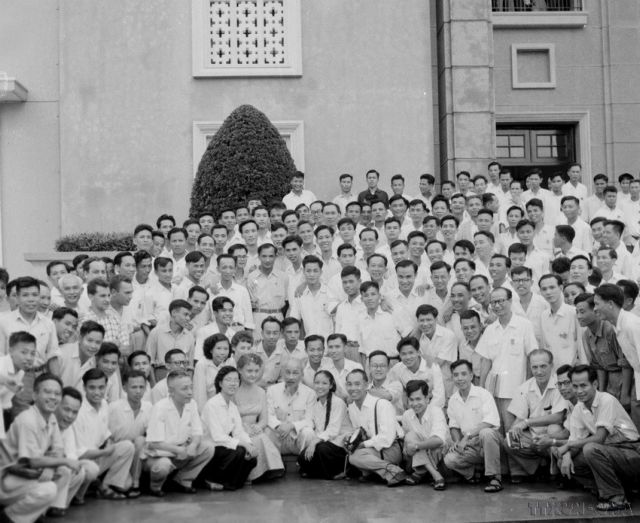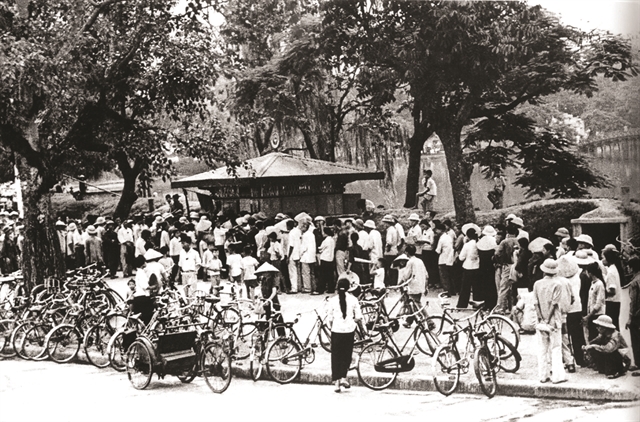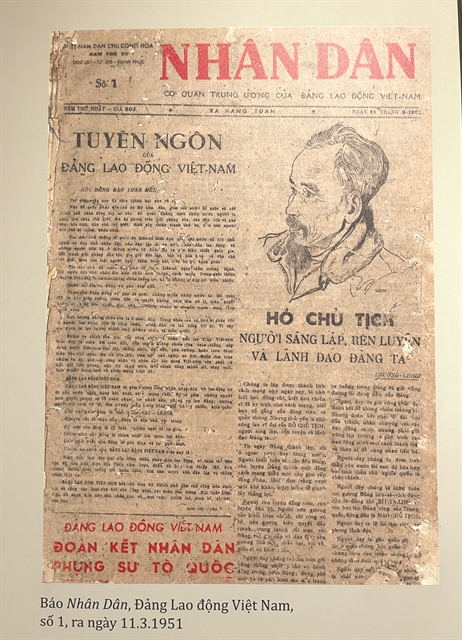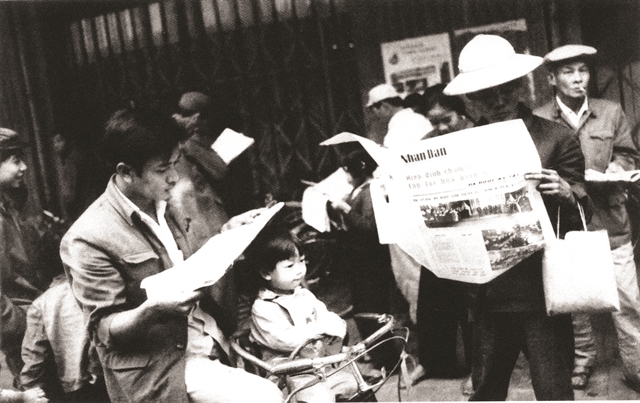 Politics & Law
Politics & Law

 |
| Photojournalists cover a major national event. VNA Photo |
By Nguyễn Khánh Chi
In the early 1920s, during his quest to find a path to liberate Việt Nam from French colonialism, Hồ Chí Minh – then known as Nguyễn Ái Quốc – was deeply influenced by Marxism-Leninism. He was particularly inspired by Soviet leader Vladimir Lenin’s assertion that “to launch and rapidly expand the revolutionary movement... a revolutionary newspaper is a must”.
Motivated by this belief, he founded the Thanh Niên (Young People) newspaper in Guangzhou, China. The first issue was published on June 21, 1925, marking the birth of the Vietnamese revolutionary press.
The Vietnamese press first emerged in 1865 with the publication of Gia Định báo (Gia Định Newspaper) in romanized Vietnamese in Sài Gòn. Throughout the late 19th century, Vietnamese-language newspapers remained limited in number.
In the early 1920s, though politically dominated by colonialism, progressive Vietnamese and French language newspapers appeared, aiming to awaken the national spirit and criticize the oppressive colonial and feudal systems.
Among the most influential were Tiếng Dân (The People's Voice), Khai Hóa (Civilisation), Đông Pháp thời báo (The Eastern France Times), and Đông Tây tuần báo (East-West Weekly), among others.
The establishment of Thanh Niên arose from an objective and inevitable need of the Vietnamese revolution, as well as from the universal role of the press in revolutionary dissemination, Lê Đức Hoàng of the Academy of Journalism and Communication wrote in his study The Role of Thanh niên Newspaper in the Vietnamese Revolutionary Press, 1925–1930.
 |
| A display at the Vietnam Press Museum showcases the original publishing site of the Thanh Niên (Young People) newspaper, Việt Nam's first revolutionary publication. VNS Photo Khánh Chi |
Stemming from his foundational belief that the country be completely independent, and that compatriots have sufficient food, clothing and access to education, Nguyễn Ái Quốc (who later became President Hồ Chí Minh of the independent Việt Nam in 1945) clearly defined the principles and purpose of Việt Nam's revolutionary press.
Following Thanh Niên, Nguyễn Ái Quốc published other newspapers such as Kông nông (Workers and Farmers) in 1926 and Lính Kách mệnh (Revolutionary Soldiers) in 1927.
Subsequently, several revolutionary newspapers and magazines emerged to promote national independence. Publications in the late 1920s like Đồng thanh, Búa liềm, Công hội Đỏ and Lao động were secretly handed on in Việt Nam and abroad. They played a key role in spreading Marxism-Leninism, fostering patriotism and encouraging a spirit of resistance.
Six months after its establishment in February 1930, the Communist Party of Việt Nam published Đỏ (Red) magazine and Tranh Đấu (Struggle) newspaper.
In the 1925-1945 period, more than 270 newspapers and magazines were published, becoming an effective tool to encourage patriotism as well as the will to unite and rise up to gain independence and freedom, creating the earth-shaking momentum of the August 1945 General Uprising.
In the article Hồ Chí Minh’s Viewpoints on Press in the Journal of State Organisation and Labour in 2015, President Hồ's core principles for journalism were quoted saying "journalists are regarded as revolutionary fighters, and their pens were sharp weapons in the cause of upholding righteousness and combating evil".
 |
| President Hồ Chí Minh posing for a group photo with Vietnamese and foreign journalists who were covering the third National Party Congress in Hà Nội in September 1960. VNA/VNS File Photo |
A century of service
The development of Việt Nam's revolutionary press is intrinsically tied to the nation's historical struggle for liberation, independence and ongoing development. Its history can be divided into six distinct phases, each reflecting its roles and missions, as well as the country's primary objectives at the time.
The initial phase, from 1925 to 1945, was dedicated to disseminating revolutionary ideas and mobilising the populace for the fight for national independence.
"These historic contributions affirmed that within its first 20 years, Việt Nam's revolutionary press had already distinguished itself, brilliantly executing its vital role as a vanguard force and a formidable ideological weapon for the Party," said Đào Duy Quát, a former deputy head of the Party Central Committee's Commission for Ideology and Culture.
Following the August Revolution, the press in the 1945-1954 period was tasked with supporting the war of resistance against foreign invaders while beginning the work of nation-building.
 |
| Hà Nội residents gather on Hoàn Kiếm Lake to listen to a radio broadcast announcing the passing of President Hồ Chí Minh in September 1969. VNA Photo. |
The resistance war against the French was fought not only on the battlefield but also on the pages of newspapers and through the air waves, said Nguyễn Danh Tiên of the Hồ Chí Minh National Academy of Politics.
According to Tiên, during this period, a surge in revolutionary media occurred. Major newspapers like Sự thật (Truth), Độc Lập (Independence), and Lao Động (Labour) were founded or revived to rally the public. Meanwhile, established papers such as Cờ Giải Phóng (Liberation Flag) and Cứu Quốc (National Salvation) expanded their reach, becoming powerful voices in shaping public discourse.
They were soon joined by new publications targeting specific audiences, including Quân Đội Nhân Dân (The People's Army) and Phụ Nữ Việt Nam (Vietnamese Women).
Upon President Hồ's order, the Vietnam News Agency announced its establishment on September 15, 1945, when Hà Nội Radio Station broadcast its first major bulletin: the full Declaration of Independence and the new Government's roster in Vietnamese, English and French.
This followed the launch of another critical platform just a week earlier, when The Radio the Voice of Vietnam went on the air for the first time on September 7.
On March 11, 1951, Nhân Dân (The People)—the central agency of the Workers' Party of Vietnam and the successor to Sự thật (Truth)—published its first issue.
 |
| A copy of the first issue of the Nhân Dân (The People) newspaper, dated March 11, 1951, on display at the Vietnam Press Museum. VNS Photo Khánh Chi |
From 1954 to 1975, the press's mission evolved to building and defending the socialist North, aiding the revolutionary cause in the South, and working towards national reunification.
Following the establishment of the National Front for the Liberation of South Việt Nam, press activities in the liberated areas grew significantly. This effort attracted many veteran journalists from the resistance war against the French colonialists, who were then assigned to continue their work in urban centres across the South.
This period saw the founding of key media outlets Thông tấn xã Giải phóng (Liberation Press Agency) in 1960, and Đài phát thanh Giải phóng (Liberation Radio) in 1962.
A new medium was introduced with the establishment of Vietnam Television, which aired its first official programme to audiences in Hà Nội on January 27, 1971.
 |
| Exhibits at the Vietnam Press Museum mark the arrival of television in North Việt Nam in early 1971. VNS Photo Khánh Chi |
The growth of the media during this era was substantial. According to the 2000 Press Yearbook, a total of 80 newspapers and magazines were published between 1960 and 1975, including publications in foreign languages.
Hundreds of journalists and press technicians sacrificed their lives during the wars against foreign aggression. Their sacrifice was essential to creating journalistic works that vividly and promptly captured the combat life of our soldiers and people.
Statistics indicate that across the nation, over 500 journalists were killed in the line of duty, while hundreds of others were left with lifelong injuries.
 |
| Hà Nội residents read newspapers for updates on the Paris Conference in early 1973. VNA/VNS File Photo |
After national reunification, the period from 1975 to 1986 saw the press focus on the immense tasks of national reconstruction and defence.
“During the endeavour to build socialism, the revolutionary press has been a vital link connecting the Party, the State and the people. It functions as a tool for leadership, organising the execution of strategic goals," said Professor Tạ Ngọc Tấn, deputy chairman of the Central Theoretical Council of the Communist Party of Việt Nam.
The launch of major economic reforms marked the fifth phase from the mid-1980s to the turn of the century, where the press became a crucial tool in serving the cause of comprehensive national renewal.
Since then, the focus has shifted to promoting industrialisation and modernisation, paving the way for Việt Nam to enter a new era.
 |
| The Voice of Vietnam reporters on assignment, covering the developments of the COVID-19 pandemic in 2021. VNA Photo |
A digital evolution
For a century, from its challenging beginnings, the Vietnamese revolutionary press has continually matured and expanded in terms of personnel, the number of agencies and media formats. With increasingly modern technology and infrastructure, it now meets the information needs of the digital era.
"Many press agencies have developed into multimedia organisations of regional and international stature," said Trần Cẩm Tú, Politburo member and member of the Communist Party of Việt Nam Central Committee’s Secretariat.
"The ranks of journalists are increasingly strong – steadfast in their political conviction, professionally skilled, exemplary in their ethics and effectively fulfilling their social responsibilities."
According to the article An Overview of Vietnamese Revolutionary Press, 2006-2025 published by Nhân Dân, it has been a time defined by the country's push for renewal and deeper global integration, set against the backdrop of a challenging world economy and the meteoric rise of digital media.
The last two decades have marked a disruptive technological shift, forcing Vietnamese journalism to reinvent its operations, production and public role. Since 2010, the rise of the internet, smartphones and social media has upended how news organisations reach their audience.
Legacy media has had to transition to digital-first strategies, building integrated newsrooms to create and distribute content in multiple formats across all major platforms, from websites and apps to YouTube and TikTok.
This social media boom also pitted mainstream journalism against a rising tide of fake news and disinformation. Fact-checking, accuracy and accountability became the core battleground separating the professional press from unregulated online content.
The pandemic from 2020 made digital transformation a matter of survival. Press agencies accelerated their adoption of AI for everything from content creation and data analysis to personalising user experience and streamlining editing. Technologies like automated reporting, chatbots and machine translation are quickly moving from experimental stages to widespread implementation.
 |
| Pictured is the front page of Việt Nam News from November 9, 2023. The cover illustration, created by AI, highlights corporate efforts to advance national sustainability. VNS Photo Ly Ly |
In legal terms, the enactment of the 2016 Press Law marked a significant milestone, replacing the 1989 version (as amended in 1999) and designed to adapt press regulations to the modern context.
Furthermore, the Law on Cybersecurity, effective from January 2019, established new operational standards for the Vietnamese press.
"This new era presents a new, more demanding mission for our revolutionary press. Journalism must rise to the occasion, evolving alongside the nation to become truly professional, humane and modern," said Nguyễn Trọng Nghĩa, Politburo member and chairman of the Party Central Committee's Commission for Information, Education and Mass Mobilisation. VNS
 |
| 100 years of Việt Nam's revolutionary press |


.jpg)

